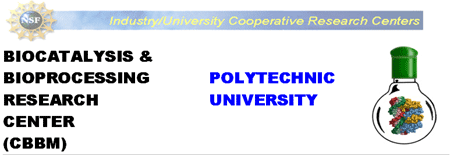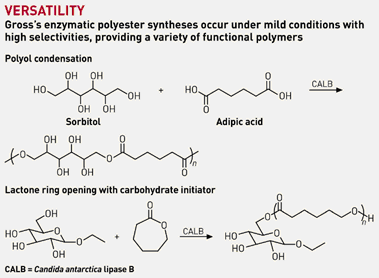MAIN
_ Home
_ Overview
_ NSF
Staff
_ Professor Gross
_ Group Members
_ Group Alumni
_ Group Pictures
Resources
_ Research
_ Instruments
_ Collaborations
News
_ Press Clippings
_ Relevant Links
Literature
_ Publication
_ Patents
Contact
_ General
_ Instrument Analysis
_ Group Contact
 |
MAIN> NSF

BIOCATALYSIS AND BIOPROCESSING OF MACROMOLECULES: A NATIONAL SCIENCE FOUNDATION INDUSTRY/UNIVERSITY COOPERATIVE RESEARCH CENTER
Enzymes are highly versatile catalysts that offer great promise for use in Polymer Chemistry. They are well known for their ability to operate under mild conditions, with impressive selectivity, on a diverse range of natural and non-natural substrates. These characteristics provide exciting opportunities to create monomers, macromers and polymers that were previously unavailable or are impractical to produce via chemical methods. The rapid pace of development in biotechnology has made available a wide array of robust enzymes. Furthermore, powerful techniques are now available to engineer and manufacture enzymes that are specifically designed for selected monomer and polymer targets. The Center is applying the rapidly evolving capabilities of enzyme technology to meet current and future needs for polymers and materials.
POLYMER RESEARCH AT THE POLYTECHNIC UNIVERSITY:
Polytechnic University, fondly known to many as ‘Brooklyn Poly’, was the first to establish a graduate program in Polymer Science. The Polytechnic is steeped in a tradition of excellence in Polymer Research and has sent into the world many of today’s leaders in the field. Today, the Polytechnic University is embracing a new frontier at the interface of Engineering, Macromolecules and the Biological sciences. Major transformations are underway at the Polytechnic to make the University a world leader in Biomacromolecular Science and Engineering.
VISION:
We stand at the threshold of a revolution in the way Industry will look towards biologically based materials and processes. The launching of new products is increasingly dependent on cradle-to-grave assessments. Significant additional costs will be imposed on industry for the disposal of toxic chemicals and by-products. These considerations will accelerate the rate-of-change in the way that chemistry and processes are designed and conducted. Completely new methods will emerge that reach well beyond incremental improvements to the discovery of new paradigms in synthesis and processing.
Biocatalysis, whether using isolated enzymes or whole cells, offers unique opportunities to meet the evolving needs of environmentally compatible processes. In reviewing the level of activity and knowledge in biocatalysis, we found a substantial effort in the development of low molar mass molecules but polymers have received much less attention. A need was expressed by industry for a cost-effective mechanism that would allow them to rapidly get up-to-speed in Biocatalysis and Bioprocessing, determine opportunities in the field, gain access to ideas and new technology, initiate projects of interest for which they did not have sufficient resources, and find business partners that compliment their expertise. To meet these needs, the NSF Center on Biocatalysis and Bioprocessing of Macromolecules (NSF-BBM) was established in April 2000.
WHY ENZYME-CATALYSIS?
The following describes how biocatalysts are being applied by the ‘Center’ to create new technologies for polymer/material synthesis, processing and utilization:
Control of Polymer Structure:
Enzyme selectivity can be directed towards the synthesis of unique monomers, macromers and polymers. Functionality that would otherwise be difficult to achieve without protection-deprotection steps can be attained by regioselective transformations.
Simplicity of Reactions Over an Ever-Widening Range of Conditions:
An important feature of biocatalytic reactions is the growing range of reaction conditions in which it can be performed. These include bulk systems, organic solvents, biphasic conditions, emulsions, and in supercritical fluids.
Multistep Conversions in Aqueous Media:
Whole-cell transformations convert low-cost materials to value-added products. Concepts of metabolic engineering used in combination with enzyme evolution provide powerful methods for the development of efficient microbial catalysts.
Green Chemistry -
The use of environmentally compatible methods for synthesis and processing is good business. Enzymes allow reductions in processing temperatures, provide metal-free safe catalysts, and convert multiple-step processes to one-pot reactions. They are also made and degraded by natural processes.
Protein Engineering -
Incorporated diversity can be retrieved through structural constraints, phylogenetic diversity, random mutations or immunological constraints. Analysis of systematically varied sets of sequences is being applied to improve key enzymes under study within the Center. This strategy has the advantage of requiring orders of magnitude fewer variants than directed evolution methods, while not being constrained by structurally interpretable changes.
RESEARCH AREAS:
We are exploring how the diverse chemistries, mild reaction conditions and selectivity of enzymes can provide unique opportunities to develop new or improve existing polymer technologies. The following summarize research activities of the Center.
- Lipases, cutinases, esterases, proteases, glycosidases, peroxidases, metallo-proteins, epoxidases, transglutaminases, nitrile and epoxide hydrolases are being used as catalysts for monomer/polymer synthesis and modification.
- Assess the activity of commercial and experimental enzymes made available to the Center by our members (Novozymes, Genencor, and DNA 2.0) for polymer chemistries.
- Engineering protease, lipase, cutinase, mono-oxgenase (P450), and metallo-proteins for polymer chemistries.
- Condensation and ring-opening polymerizations.
Prepare vinyl monomers by selective acylation of natural building blocks (e.g. carbohydrates, amino acids and lipids).
- Prepare linear and branched polymers from polyols and other multifunctional building blocks.
- Synthesize oligopeptide building blocks for polymer synthesis/modification.
- Develop mild ‘triggered’ enzyme-catalyzed crosslinking and degradation reactions.
- Prepare macromers and polymers with narrow molecular weight distribution.
- Silicone based materials.
- Synthesis of functional bioresorbable polymers for drug delivery and tissue-engineering scaffolds.
- Controlled and selective modification of polymers and surfaces.
Design, synthesis, analysis and optimization of systems for enzyme immobilization.
- Bio-derived low and high molar mass surfactants.
Enzyme-based reactions in supercritical fluids.
Self-degrading materials.
APPLICATIONS OF MATERIALS FROM BIOCATALYSIS:
Plastics, elastomers, adhesives, coatings, macromers, functional polymers, polyurethanes, oligomer building blocks, water-soluble polymers, surfactants, vinyl monomers, cosmetics, fine chemicals, nutra-ceuticals, agricultural materials, bioresorbable polymers, scaffolds for tissue engineering, protein therapeutics, modified peptides, functionalized surfaces.
CENTER STAFF:
Professor Richard A. Gross and the other faculty participants have recruited talented Research fellows that bring their energy and expertise in biochemistry, microbiology, protein engineering, surface modification, monomer/polymer synthesis, polymer physics and characterization. These postdoctoral fellows work in interdisciplinary teams with graduate and undergraduate students. The Center has assembled the following Senior Faculty and Scientists from a wide-range of participating universities that bring their talents and expertise (in alphabetical order):
Professor Stephen Clarson enzymatic reactions used by diatoms and sponges, (bio)silicon chemistry) University of Cincinatti; Katja Loos, characterization of surfaces, block copolymer self-assembly) Univ. of Groningen; Dr. Lisa Miller (IR microspectroscopy, Brookhaven National Laboratory); Professor Jin Kim Montclare (protein engineering, non-natural amino acids) Polytechnic University; Professor Fred Naider (peptide synthesis and characterization) CUNY Staten Island; Professor Miriam Rafailovich (Surface engineering and characterization: SUNY at Stony Brook, L.I., NY); Professor Maristella Scandola (Solid-state material properties; University of Bologna, Italy); Professor Iwao Teraoka (Polymer Physics and chromatograph; Polytechnic University); Professor Evgeny Vulfson (development of pharmaceutical/health care agents) Polytechnic University; Professor Shiquin Zhou (Self-association phenomena, CUNY Staten Island).
WORKING TOGETHER: AN INDUSTRY-UNIVERSITY PARTNERSHIP
Become a part of the action:
Become a part of the action: Members that join the Center become ‘true partners’. Industrial scientists work with the Center Director and staff to create a research program that is responsive to their needs. The Members: i) prioritize the projects performed, ii) are encouraged to propose and initiate Center projects, iii) can provide their materials (enzymes, substrates, monomers, polymers), iv) can work closely with Center postdocs and graduate students. Researchers at member companies who become part of a project team maybe co-inventors on patents and co-authors in publications. The Center allows Members to monitor the latest developments in this rapidly emerging field. We know Members must get the most out of their financial and time investment in the Center and we make sure they do. Other benefits enjoyed by our Members include:
-
Cost-effective involvement with a portfolio of research projects.
-
Balance between long term (multi-year) and short term (6-month) projects.
-
Rapid information transfer through frequent reports, semi-annual meetings, and direct contact with faculty and Center staff.
-
Access to highly trained employees.
-
Develop contacts and business partnerships.
-
Reduction in overhead on membership fees from 67 to 10%.
-
Access of members to other federally funded projects that increase the Center budget in 2006-2008 to about $2.3 M.
-
Only Members are eligible to enter into exclusive research agreements with Center faculty on Confidential Center Research. This mechanism provides Members with an opportunity to direct funds to proprietary commercial targets.
-
Access to highly specialized equipment.
CBBM projects are reviewed and may be modified every six months. This allows Center research to adapt and evolve within short time spans. Program flexibility is achieved by involvement of postdoctoral fellows and by having Center graduate students develop their thesis based on two or three related topics.
Some benefits to members are more subtle but provide powerful arguments to management for participation. For example, Center research may save Members from investing in similar projects that, if performed in house, would be much more costly. Also, by participation, Members can rapidly target promising new technologies for in-house investment. The membership fee is 50 K per year for medium and large companies and members commit to only two years of participation. Thus, the yearly membership fee is about 1/6th the cost to hire a full time employee.
PATENTS, PUBLICATIONS, and INTELLECTUAL PROPERTY
The publication of commercially important results is delayed to allow sufficient time to further develop the work so that the value of the patents is enhanced. Patents resulting from research sponsored by the Center are administered by the University. When the intellectual property developed is the result of collaborations between a Member and the Center, joint patents and ownership results. Our industrial members have the first rights to exclusive or non-exclusive licenses. Licenses may be divided based on field of use to increase exclusive licensing opportunities. Upon request, the Center Director and staff will cease research in areas that might conflict with those identified by our members who are working towards application patents.
Patents are actively pursued. As of September 2005, 14 patents have been granted (US 6,424,271; US 6,486,295; US 6,316,581; US 6,093,792; 5,378,807; US 5,440,007; US 5,439,985; WO9961482AI; US 05981743; US 05883199; WO 97071531AI; WO 09724387A1. Ten applications are currently active within the US Patent office.
INDUSTRIAL MEMBERS:
As of September 2005, the industrial members include: BASF, Bayer, DeGussa, DNA 2.0, Esteé Lauder, Genencor, Grace Chem. Co., Grain Processing Corp., Novozymes.
PRESIDENTIAL HONOR:
The Center was the recipient of the 2003 Presidential Green Chemistry Award winner in the academic category. The award honors the Centers research on a broad range of research on lipase-catalyzed polyester syntheses.

FACILITIES AND EQUIPMENT
-
High Field, multi-nuclear NMR.
-
MALDI-TOF.
-
ATR and other surface FT-IR.
-
Particle size analyzers.
-
Electron Microscopy and X-ray diffractometers.
-
Thermal analysis lab (DSC, TGA, DMA).
-
Static and Dynamic Light Scattering.
-
GC-MS, LC-MS, MALDI-TOF.
-
SEC systems with RI, UV, IR, evaporative, MALLS and viscosity detectors.
-
Bioreactors (including parallel fermentors).
-
PCR and gel documentation.
-
Microbiology lab: Deep freezers, freeze dryer, shaker/incubator, centrifuges, autoclaves.
-
FPLC and preparative HPLC.
-
Dielectric Spectroscopy, Rheometers.
-
UV-vis, Fluor., microplate spectrophotometers.
-
Atomic Force Microscopy.
-
IR imaging.
-
Optical microscopes.
-
Parallel Synthesizers.
-
Kruss Tensiometers.
FURTHER INFORMATION: Visit our Web site: http://www.poly.edu/grossbiocat/ or contact:
Professor Richard A. Gross
Director
Center for Biocatalysis & Bioprocessing of Macromolecules
rgross@poly.edu
Phone: (718)-260-3024
Fax: (718)-260-3075
Ms. Josephine Rodriguez
Administrative Assistant
CBBM
jrodrigu@duke.poly.edu
Phone (718)-260-3984
Fax: (718)-260-3075 |

